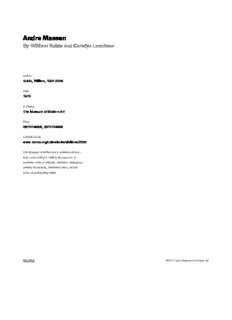
Andre Masson PDF
Preview Andre Masson
AAnnddrree MMaassssoonn BByy WWiilllliiaamm RRuubbiinn aanndd CCaarroollyynn LLaanncchhnneerr Author Rubin, William, 1927-2006 Date 1976 Publisher The Museum of Modern Art ISBN 0870704656, 0870704648 Exhibition URL www.moma.org/calendar/exhibitions/2000 The Museum of Modern Art's exhibition history— from our founding in 1929 to the present—is available online. It includes exhibition catalogues, primary documents, installation views, and an index of participating artists. MoMA © 2017 The Museum of Modern Art 232 pages 235 illustrations (24 in color) $20.00 ANDMREA SSON BY WILLIAM RUBIN AND CAROLYN LANCHNER In the MiD-twenties, on seeing Masson's work, Picasso noted with humorous resentment that the young painter had "turned Cubism inside out." Masson had rejected the shel tered life that he felt was implicit in Cubist painting, and he had forced the Cubist pictorial syntax to deal with birth, death, sex, war, and the dark recesses of the mind. His art confronts the universal lot of man, but it is rooted in the particulars of twentieth-century experience, of his own turbulent life. He was gravely wounded in World War I. During the twenties he took part in the Surrealist venture at revolutionizing the world. He was in Spain during the Civil War. World War II meant exile for him, in America, and his return to France brought not only the pastoral satisfactions of his homeland and the attractions of its capital, but also involvement in the Algerian conflict. In art, Masson's role was crucial in determining the form that Surrealist painting assumed during its first phase. He virtually invented automatic drawing as understood by the Surrealists, and he extended the automatist approach into his painting. In 1926-27, in a daring series of works executed by randomly dripping glue on a flat canvas which he then sprinkled with sand, Masson evolved a technique that both in its means and its effects anticipated post-World War II American painting. It is not surprising to find in these works an adumbration of the kind of painting that is often charac terized by the word "action," for common to Masson's work of every period is a sense of energy and movement. The present book, published in conjunction with a major retrospective exhibition, is a definitive study of the painter, tracing his career from its beginnings in Cubism in 1922 to the present, with particular emphasis on the early Surrealist period from 1925 to 1928 and the American period from 1941 to 1945. In a concise yet comprehensive essay, Mr. Rubin analyzes and assesses Masson's signal contribution to twen tieth-century art. Ms. Lanchner illuminates his iconography, with its bases in myth, philosophy, and personal experience, as she surveys the development of his work over five dec ades. A wide selection of illustrations, including twenty-four in color, documents the full range of Masson's art. A detailed chronology and a comprehensive bibliography complete the volume. William Rubin, author of numerous books on twentieth-cen tury art, is Director of the Department of Painting and Sculp ture at The Museum of Modern Art, New York. Carolyn Lanchner is Research Curator of Painting and Sculpture at the same institution. WILLIAM RUBIN CAROLYN LANCHNER THE MUSEUM OF MODERN ART NEW YORK Copyright © 1976 by The Museum of Modern Art All rights reserved Library of Congress Catalog Card Number 76-1492 Clothbound ISBN 0-87070-465-6 Paperbound ISBN 0-87070-464-8 Designed by Carl Laanes Type set by Custom Composition, Inc., York, Pa. Printed by Rae Publishing Co., Inc., Cedar Grove, N.J. The Museum of Modern Art 11 West 53 Street New York, N.Y. 10019 Printed in the United States of America Cover: Detail from Entanglement. 1941 Frontispiece : Andre Masson. Paris, 1976 LIST OF ILLUSTRATIONS 6 ACKNOWLEDGMENTS 9 ANDRE MASSON AND TWENTIETH-CENTURYP AINTING 11 by William Rubin ANDRE MASSON: ORIGINS AND DEVELOPMENT 79 by Carolyn Lanchner REFERENCEIL LUSTRATIONS 207 CHRONOLOGY 211 BIBLIOGRAPHY 225
Description: